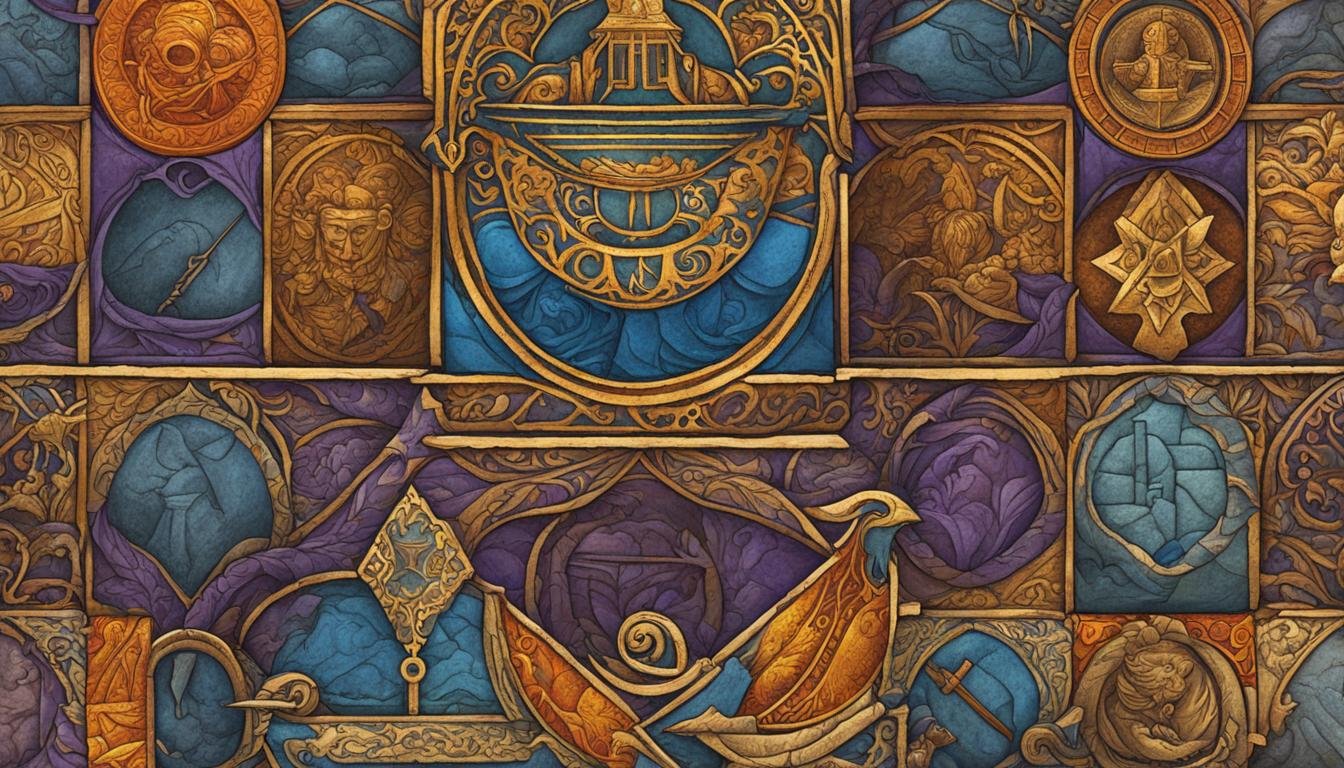The Bible contains a significant number of seals, but one particular set of seals holds great intrigue and symbolism. These are the seven seals of Revelation, which play a crucial role in biblical prophecy and eschatology.
Referred to as the biblical seals, the seven seals of Revelation are opened by Jesus Christ and represent specific time periods in which significant events will unfold on earth. Found in the book of Revelation, each of these seals unveils a different picture or representation of the events that will occur during its respective time period.
The seven seals in the Bible are as follows:
- The white horse
- The red horse
- The black horse
- The pale horse
- Souls crying out from under the altar
- Earthquake and celestial phenomena
- Silence in heaven
Key Takeaways:
- The seven seals of Revelation are a set of biblical seals that represent specific time periods and events.
- Each seal reveals a different picture or representation of the events that will occur during its respective time period.
- The symbolism of the seals includes victory, war, famine, death, martyrdom, cataclysmic events, and temporary peace.
- Various interpretations exist, including historical, end times, and symbolic interpretations.
- The message of the seals remains relevant today, emphasizing the triumph of righteousness and the need for spiritual preparedness.
Understanding the Symbolism of the Seven Seals
The opening of the seals in Revelation is filled with rich symbolism that holds deep meaning. Each seal represents a different aspect of the unfolding events, offering a glimpse into the divine plan. Understanding the symbolism of these seals allows us to better grasp the profound messages contained within the book of Revelation.
Starting with the first seal, the white horse signifies victory and purity. It represents the triumph of righteousness and the coming of the conquering Messiah. As the seal is opened, the rider on the white horse emerges, symbolizing the victorious reign of Jesus Christ.
“I looked, and there before me was a white horse! Its rider held a bow, and he was given a crown, and he rode out as a conqueror bent on conquest.”
The following seals continue to convey profound symbolism. The red horse, representing war and bloodshed, reminds us of the turbulent nature of human existence. The black horse symbolizes famine and scarcity, highlighting the consequences of human greed and injustice. The pale horse represents death and hell, serving as a stark reminder of the finite nature of life and the ultimate judgment to come.
The fifth seal unveils the souls of martyrs crying out for justice. This powerful image highlights the suffering and persecution endured by believers throughout history and emphasizes the importance of standing for truth and righteousness. The sixth seal signifies cataclysmic events and signals the end times, serving as a warning of the coming judgment. Finally, the seventh seal brings a temporary peace before the final judgment, reminding us of the need for spiritual preparation and readiness for what lies ahead.
| Seal | Symbolism |
|---|---|
| First | Victory and purity |
| Second | War and bloodshed |
| Third | Famine and scarcity |
| Fourth | Death and hell |
| Fifth | Souls crying out for justice |
| Sixth | Cataclysmic events and end times |
| Seventh | Temporary peace before final judgment |
The symbolism of the seven seals in Revelation urges us to reflect on the state of the world and our own spiritual journey. It serves as a reminder of the ongoing struggle between good and evil, the importance of righteousness, and the need for spiritual preparedness. By delving into their profound meanings, we can gain a deeper appreciation for the divine plan and find guidance in navigating the challenges of our time.

Significance and Interpretation of the Seven Seals
The seven seals hold immense significance in biblical prophecy and have been subject to various interpretations throughout history. These seals, described in the book of Revelation, provide a glimpse into the events that will unfold on earth during specific time periods.
One interpretation of the seals is held by preterists, who view them as representing historical events that have already occurred. According to this perspective, the seals symbolize significant events from the early church until the fall of the Western Roman Empire.
On the other hand, historicists interpret the seals as spanning a broader timeframe, representing major events and eras in history. They view the seals as a symbolic representation of the ongoing struggle between good and evil throughout different periods.
Futurists, on the other hand, believe that the seals represent prophecies of the end times and the reign of the antichrist. They see the opening of the seals as future events that are yet to take place.
Lastly, idealists see the seals as symbolic of the timeless struggle between good and evil in every generation. They emphasize the enduring relevance of the message conveyed by the seals, reminding believers of the ultimate triumph of righteousness and the necessity for spiritual preparedness.
The interpretation of the seven seals may vary, but their significance remains. These seals serve as a reminder of the divine plan, encouraging believers to seek spiritual growth, faith, and righteousness in today’s world.
FAQ
How many seals are there in the Bible?
There are seven seals in the Bible.
What do the seven seals in the Bible represent?
The seven seals represent events that will take place on earth during specific time periods.
Where are the seals found?
The seals are found in the book of Revelation.
Who opens the seals?
The seals are opened by Jesus Christ.
What does each seal reveal?
Each seal reveals a different picture or representation of events that will occur during that seal’s time period.
What are the different symbols of the seven seals?
The symbols of the seven seals include the white horse, red horse, black horse, pale horse, souls crying out from under the altar, earthquake and celestial phenomena, and silence in heaven.
What does the white horse symbolize?
The white horse symbolizes victory and purity.
What does the red horse symbolize?
The red horse symbolizes war and bloodshed.
What does the black horse symbolize?
The black horse symbolizes famine and scarcity.
What does the pale horse symbolize?
The pale horse symbolizes death and hell.
What does the fifth seal portray?
The fifth seal portrays the souls of martyrs crying out for justice.
What does the sixth seal bring?
The sixth seal brings cataclysmic events and signals the end times.
What does the seventh seal bring?
The seventh seal brings a temporary peace before the final judgment.
How are the seven seals interpreted by different views?
The seven seals are subject to various interpretations by preterists, historicists, futurists, and idealists.
How do preterists interpret the seals?
Preterists view the seals as representing historical events.
How do historicists interpret the seals?
Historicists see the seals as spanning the time period from the early church to the fall of the Western Roman Empire.
How do futurists interpret the seals?
Futurists interpret the seals as prophecies of the end times and the reign of the antichrist.
How do idealists interpret the seals?
Idealists view the seals as symbolic of the ongoing struggle between good and evil.
What is the message of the seals in today’s world?
Regardless of the interpretation, the message of the seals remains relevant in today’s world, reminding believers of the ultimate triumph of righteousness and the need for spiritual preparedness.

I’m Benjamin, a passionate spiritual seeker and creator of Verses and Prayers. Alongside my girlfriend Emma and our pet lizard Mulle, I cherish family life, enjoy exploring new places, and am deeply involved in my church community. My love for reading and singing biblical verses inspires every aspect of my journey.

